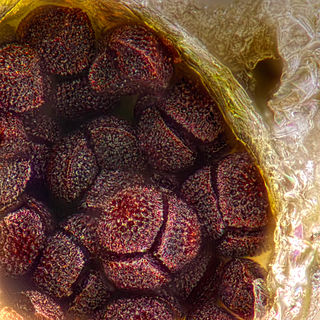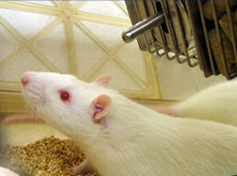A gene knockout is a genetic technique in which one of an organism's genes is made inoperative. However, KO can also refer to the gene that is knocked out or the organism that carries the gene knockout. Knockout organisms or simply knockouts are used to study gene function, usually by investigating the effect of gene loss. Researchers draw inferences from the difference between the knockout organism and normal individuals.
Protein engineering is the process of developing useful or valuable proteins. It is a young discipline, with much research taking place into the understanding of protein folding and recognition for protein design principles. It is also a product and services market, with an estimated value of $168 billion by 2017.

A cloning vector is a small piece of DNA, taken from a virus, a plasmid, or the cell of a higher organism, that can be stably maintained in an organism, and into which a foreign DNA fragment can be inserted for cloning purposes. The vector therefore contains features that allow for the convenient insertion or removal of a DNA fragment to or from vector, for example by treating the vector and the foreign DNA with a restriction enzyme that cuts the DNA. DNA fragments thus generated contain either blunt ends or overhangs known as sticky ends, and vector DNA and foreign DNA with compatible ends can then be joined together by molecular ligation. After a DNA fragment has been cloned into a cloning vector, it may be further subcloned into another vector designed for more specific use.
This is a list of topics in molecular biology. See also index of biochemistry articles.
Site-specific recombinase technologies are genome engineering tools that depend on recombinase enzymes to replace targeted sections of DNA.
Mitotic recombination is a type of genetic recombination that may occur in somatic cells during their preparation for mitosis in both sexual and asexual organisms. In asexual organisms, the study of mitotic recombination is one way to understand genetic linkage because it is the only source of recombination within an individual. Additionally, mitotic recombination can result in the expression of recessive genes in an otherwise heterozygous individual. This expression has important implications for the study of tumorigenesis and lethal recessive genes. Mitotic homologous recombination occurs mainly between sister chromatids subsequent to replication. Inter-sister homologous recombination is ordinarily genetically silent. During mitosis the incidence of recombination between non-sister homologous chromatids is only about 1% of that between sister chromatids.
Recombineering is a genetic and molecular biology technique based on homologous recombination systems, as opposed to the older/more common method of using restriction enzymes and ligases to combine DNA sequences in a specified order. Recombineering is widely used for bacterial genetics, in the generation of target vectors for making a conditional mouse knockout, and for modifying DNA of any source often contained on a bacterial artificial chromosome (BAC), among other applications.

Sister chromatid exchange (SCE) is the exchange of genetic material between two identical sister chromatids.

In genetics, Flp-FRT recombination is a site-directed recombination technology, increasingly used to manipulate an organism's DNA under controlled conditions in vivo. It is analogous to Cre-lox recombination but involves the recombination of sequences between short flippase recognition target (FRT) sites by the recombinase flippase(Flp)derived from the 2 µm plasmid of baker's yeast Saccharomyces cerevisiae.
Balancer chromosomes are special, modified chromosomes used for genetically screening a population of organisms to select for heterozygotes. Balancer chromosomes can be used as a genetic tool to prevent crossing over between homologous chromosomes during meiosis. Balancers are most often used in Drosophila melanogaster genetics to allow populations of flies carrying heterozygous mutations to be maintained without constantly screening for the mutations but can also be used in mice. Balancer chromosomes have three important properties: they suppress recombination with their homologs, carry dominant markers, and negatively affect reproductive fitness when carried homozygously.

The tetrad is the four spores produced after meiosis of a yeast or other Ascomycota, Chlamydomonas or other alga, or a plant. After parent haploids mate, they produce diploids. Under appropriate environmental conditions, diploids sporulate and undergo meiosis. The meiotic products, spores, remain packaged in the parental cell body to produce the tetrad.
Transposon mutagenesis, or transposition mutagenesis, is a biological process that allows genes to be transferred to a host organism's chromosome, interrupting or modifying the function of an extant gene on the chromosome and causing mutation. Transposon mutagenesis is much more effective than chemical mutagenesis, with a higher mutation frequency and a lower chance of killing the organism. Other advantages include being able to induce single hit mutations, being able to incorporate selectable markers in strain construction, and being able to recover genes after mutagenesis. Disadvantages include the low frequency of transposition in living systems, and the inaccuracy of most transposition systems.

A knockout rat is a genetically engineered rat with a single gene turned off through a targeted mutation used for academic and pharmaceutical research. Knockout rats can mimic human diseases and are important tools for studying gene function and for drug discovery and development. The production of knockout rats was not economically or technically feasible until 2008.
A knockout mouse or knock-out mouse is a genetically modified mouse in which researchers have inactivated, or "knocked out", an existing gene by replacing it or disrupting it with an artificial piece of DNA. They are important animal models for studying the role of genes which have been sequenced but whose functions have not been determined. By causing a specific gene to be inactive in the mouse, and observing any differences from normal behaviour or physiology, researchers can infer its probable function.
Mutagenesis in the laboratory is an important technique whereby DNA mutations are deliberately engineered to produce mutant genes, proteins, strains of bacteria, or other genetically modified organisms. Various constituents of a gene, such as its control elements and its gene product, may be mutated so that the functioning of a gene or protein can be examined in detail. The mutation may also produce mutant proteins with interesting properties, or enhanced or novel functions that may be of commercial use. Mutant strains may also be produced that have practical application or allow the molecular basis of particular cell function to be investigated.
Cassette mutagenesis is a type of site-directed mutagenesis that uses a short, double-stranded oligonucleotide sequence to replace a fragment of target DNA. It uses complimentary restriction enzyme digest ends on the target DNA and gene cassette to achieve specificity. It is different from methods that use single oligonucleotide in that a single gene cassette can contain multiple mutations. Unlike many site directed mutagenesis methods, cassette mutagenesis also does not involve primer extension by DNA polymerase.
Synthetic genome is a synthetically-built genome whose formation involves either genetic modification on pre-existing life forms or artificial gene synthesis to create new DNA or entire lifeforms.. The field that studies synthetic genomes is called Synthetic Genomics.
SCAR-less genome editing Scarless Cas9 Assisted Recombineering (no-SCAR) is an editing method that is able to manipulate the Escherichia coli genome. The system relies on recombineering whereby DNA sequences are combined and manipulated through homologous recombination. No-SCAR is able to manipulate the E. coli genome without the use of the chromosomal markers detailed in previous recombineering methods. Instead, in this method, the λ-Red recombination system facilitates donor DNA integration while Cas9 cleaves double-stranded DNA to counter-select against wild-type cells. Although λ-Red and Cas9 genome editing are widely used technologies, the no-SCAR method is novel in combining the two functions; this technique is able to establish point mutations, gene deletions, and short sequence insertions in several genomic loci with increased efficiency and time sensitivity.












